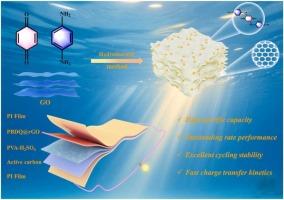Hierarchical graphene-quinone-amine polymer nanocomposites with redox activity for high-performance flexible supercapacitors
IF 6.3
2区 材料科学
Q2 CHEMISTRY, PHYSICAL
引用次数: 0
Abstract
Quinone-amine polymers possess unique unsaturated hexagonal rings along with adjacent or separated carbonyl groups, which enable efficient charge storage and excellent electrochemical performance through reversible redox reactions. These polymers are extensively utilized in supercapacitor electrodes. In this study, we synthesized a graphene-based quinone-amine polymer composite, denoted as PBDQ@rGO. PBDQ effectively prevents the restacking of graphene layers while introducing pseudocapacitive behavior, whereas reduced graphene oxide (rGO) enhances electrical conductivity and rate capability. The synergistic interaction between PBDQ and rGO facilitates improved ion transport and overall electrochemical performance. The PBDQ@rGO-1 composite exhibits a specific capacitance of 674.5 F g−1 at a current density of 0.5 A g−1, retains 80.86 % of its capacitance at a high current density of 50 A g−1, and maintains 73.22 % of its initial capacity after 25,000 cycles. Furthermore, PBDQ@rGO-1//AC flexible asymmetric solid-state supercapacitors (FASCs) exhibit a specific capacitance of 98.7 F g−1 at 0.5 A g−1, retaining 83.0 % of its capacitance after 5,000 cycles at 10 A g⁻¹ , and achieving an energy density of 34.18 Wh kg−1 at a power density of 394.8 W kg−1. The FASC demonstrates outstanding mechanical stability under bending and twisting deformations, maintaining its electrochemical performance after 5000 cycles. In-situ and ex-situ characterization techniques were employed to elucidate the underlying energy storage mechanisms, providing a foundation for the rational design of quinone-based electrode materials.

具有氧化还原活性的石墨烯-醌-胺聚合物纳米复合材料用于高性能柔性超级电容器
醌胺聚合物具有独特的不饱和六方环和相邻或分离的羰基,通过可逆氧化还原反应实现高效的电荷存储和优异的电化学性能。这些聚合物广泛应用于超级电容器电极。在本研究中,我们合成了一种基于石墨烯的醌-胺聚合物复合材料,表示为PBDQ@rGO。PBDQ有效地防止了石墨烯层的再堆积,同时引入了假电容行为,而还原的氧化石墨烯(rGO)增强了电导率和速率能力。PBDQ和氧化石墨烯之间的协同作用有助于改善离子传输和整体电化学性能。PBDQ@rGO-1复合材料在0.5 a g-1电流密度下的比电容为674.5 F -1,在50 a g-1高电流密度下保持80.86%的电容,在25000次循环后保持73.22%的初始容量。此外,PBDQ@rGO-1//交流柔性非对称固态超级电容器(FASCs)在0.5 a g-1下的比电容为98.7 F -1,在10 a g-1下循环5000次后保持83.0%的比电容,在394.8 W kg-1的功率密度下实现34.18 Wh kg-1的能量密度。FASC在弯曲和扭转变形下表现出出色的机械稳定性,在5000次循环后仍能保持其电化学性能。利用原位和非原位表征技术阐明了醌基电极材料的潜在储能机制,为醌基电极材料的合理设计提供了基础。
本文章由计算机程序翻译,如有差异,请以英文原文为准。
求助全文
约1分钟内获得全文
求助全文
来源期刊

Journal of Alloys and Compounds
工程技术-材料科学:综合
CiteScore
11.10
自引率
14.50%
发文量
5146
审稿时长
67 days
期刊介绍:
The Journal of Alloys and Compounds is intended to serve as an international medium for the publication of work on solid materials comprising compounds as well as alloys. Its great strength lies in the diversity of discipline which it encompasses, drawing together results from materials science, solid-state chemistry and physics.
 求助内容:
求助内容: 应助结果提醒方式:
应助结果提醒方式:


